Plot
The story emphasizes the rivalry between two sheepdogs and their masters, and chronicles the maturing of a boy, David, who is caught between them. His mother dies, and he is left to the care of his father, Adam M'Adam, a sarcastic, angry alcoholic with few redeeming qualities. M'Adam is the owner of Red Wull, a huge, violent dog who herds his sheep by brute force. The other dog is Bob, son of Battle. He herds sheep by finesse and persuasion. His master is James Moore, Master of Kenmuir, who acts as surrogate father to David. David and Moore's daughter Maggie become romantically intrigued by each other. The dogs compete for the Shepherd's Trophy, the prize in an annual sheep-herding contest which is the highlight of the year in the North Country. A dog who wins three competitions in a row wins the Shepherd's Cup outright, which has never happened. Complications arise—a rogue dog is killing sheep, and both Bob and Red Wull are suspected of being the culprit. The story chronicles David's boyhood and early manhood, his struggle to live with his father, his frequent escapes to Kenmuir, and his intermittent friendship with Maggie Moore. Red Wull wins the Shepherd’s Trophy in a year when Bob does not compete. Bob later wins three straight times. Red Wull is found to be the sheep killer, but at M’Adam’s request this fact is kept secret from nearly everyone else. A pack of local dogs attacks Red Wull, who kills many of them before dying himself. M’Adam grieves and is found dead soon after.

The Australian Kelpie, or simply Kelpie, is an Australian sheepdog capable of mustering and droving with little or no guidance. It is a medium-sized dog and comes in a variety of colours. The Kelpie has been exported throughout the world and is used to muster livestock, primarily sheep, cattle and goats.

The German Shepherd, also known in Britain as an Alsatian, is a German breed of working dog of medium to large size. The breed was developed by Max von Stephanitz using various traditional German herding dogs from 1899.

The Border Collie is a British breed of herding dog of the collie type of medium size. It originates in the region of the Anglo-Scottish border, and descends from the traditional sheepdogs once found all over the British Isles. It is kept mostly as a working sheep-herding dog or as a companion animal. It competes with success in sheepdog trials. It has been claimed that it is the most intelligent breed of dog.
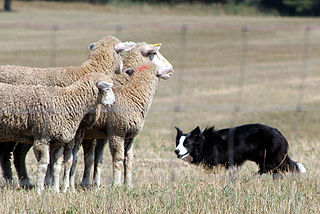
A sheepdog trial – also herding event, stock dog trial or simply dog trial — is a competition or test of the working abilities of dogs of herding breeds. It is a type of dog sport that emerged in the 1860s in New Zealand. By the 1870s regular trials were also being held in Australia and in the United Kingdom, and by the end of the twentieth century the sport had spread to many countries of the world. In competition, dogs demonstrate basic herding management skills assessed by the judge. These events are organised by international and national cynological and sports organisations and by associations of sheep- and cattle-breeders. Usually sheep are to be herded; other animals including ducks or cows may also be used.

A herding dog, also known as a stock dog or working dog, is a type of dog that either has been trained in herding livestock or belongs to one of the breeds that were developed for herding. A dog specifically trained to herd sheep is known as a sheep dog or shepherd dog.

Collies form a distinctive type of herding dogs, including many related landraces and standardized breeds. The type originated in Scotland and Northern England. Collies are medium-sized, fairly lightly-built dogs, with pointed snouts. Many types have a distinctive white color over the shoulders. Collies are very active and agile, and most types of collies have a very strong herding instinct. Collie breeds have spread through many parts of the world, and have diversified into many varieties, sometimes mixed with other dog types.
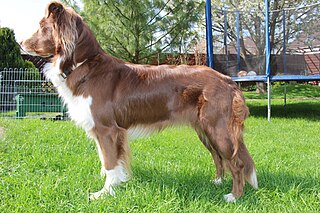
The Australian Shepherd is a breed of herding dog from the United States. The name of the breed is technically a misnomer, as it was developed in California in the 19th century. It is believed to have its origins in sheepdog breeds from northwest Spain, as well as collies imported, alongside sheep, from Australia and New Zealand; the breed reportedly took its name from this trade. Originally used solely as a herding dog, the Australian Shepherd has become one of the most popular companion dog breeds in North America.
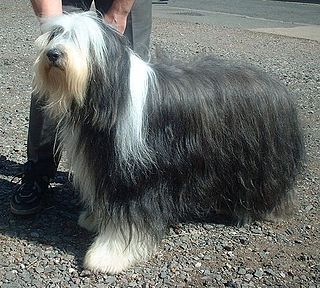
The Bearded Collie, or Beardie, is a herding breed of dog once used primarily by Scottish shepherds, but now mostly a popular family companion.

The Koolie is an Australian dog breed. The Koolie is a working or herding dog which has existed in Australia since the early 19th century when it was bred from imported British working dogs. Robert Kaleski, in an article on Cattle Dogs in the August 1903 issue of the Agricultural Gazette of New South Wales, describes the "Welsh heeler or merle, erroneously known as the German collie," as a "blue-gray dog about the size and build of a smooth-haired collie, generally with wall eyes." The British background predominated in the dogs that came to be associated with the "German collie" name.

The McNab Dog, also called the McNab Shepherd or McNab Collie is a herding dog that originated in Hopland, Mendocino County, Northern California. The McNab was bred to withstand the tough conditions found in California such as heat, burrs, foxtails, and rugged terrain. Until recently, the McNab was little known outside California, but in last three decades have seen a gain in popularity and geographic dispersal of the breed.

Alfred Ollivant (1874–1927) was an English novelist known best for his novel Owd Bob. Ollivant also published about a dozen other novels ranging from small-scale cautionary tales to grand historical stories.

Droving is the practice of walking livestock over long distances. It is a type of herding. Droving stock to market—usually on foot and often with the aid of dogs—has a very long history in the Old World. An owner might entrust an agent to deliver stock to market and bring back the proceeds. There has been droving since people in cities found it necessary to source food from distant supplies.
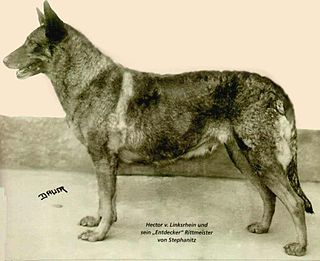
Horand von Grafrath was the first German Shepherd Dog and the genetic basis for modern German Shepherds.
Scamp is a canine Disney comics character, the son of Lady and Tramp, all of whom appear in the 1955 animated film Lady and the Tramp. Scamp is featured in comic strips and comic books of his own since the 1950s. In the final scene of the film, the dogs have a litter of puppies, including three girl pups who look like Lady, and a mischievous, restless boy pup who resembles Tramp. The puppies are unnamed in the film and only appear in one scene, but the little boy puppy made an impression, and King Features Syndicate launched a comic strip a few months after the film's release.
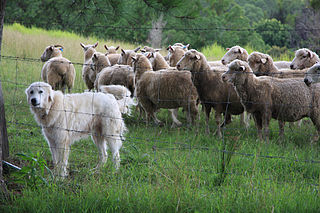
A livestock guardian dog (LGD) is a dog type bred for the purpose of protecting livestock from predators.
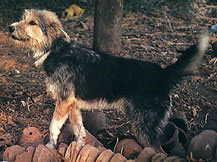
The Armant is a breed of herding dog from Egypt. The breed is not well known outside of Egypt but is used extensively within Egypt as both a herding dog and a guard dog.

A shepherd or sheepherder is a person who tends, herds, feeds, or guards flocks of sheep. Shepherd derives from Old English sceaphierde. Shepherding is one of the world's oldest occupations; it exists in many parts of the globe, and it is an important part of pastoralist animal husbandry.
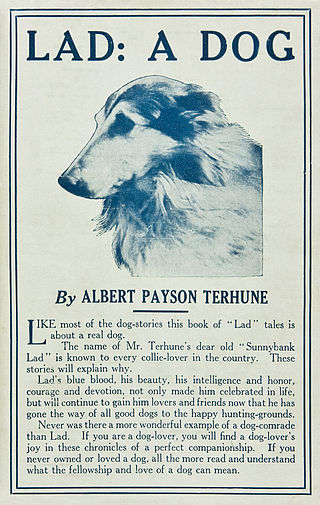
Lad: A Dog is a 1919 American novel written by Albert Payson Terhune and published by E. P. Dutton. Composed of twelve short stories first published in magazines, the novel is based on the life of Terhune's real-life Rough Collie, Lad. Born in 1902, the real-life Lad was an unregistered collie of unknown lineage originally owned by Terhune's father. Lad's death in 1918 was mourned by many of the story's fans, particularly children.

The Carea Leonés is a breed of herding dog from León, Castile and León, Spain (Europe), and is used as a sheepdog. For centuries, they tended flocks of Churra (sheep) in the mountains of the historical region of León.

Thunder in the Valley is a 1947 American Technicolor drama film directed by Louis King and starring Lon McCallister, Peggy Ann Garner and Edmund Gwenn. It is based on the 1898 novel Owd Bob by Alfred Ollivant, which has previously been adapted into a 1938 film of the same title. The film was produced and distributed by 20th Century Fox and cost a reported $1.9 million. It was released in Britain under the alternative title Bob, Son of Battle.


















